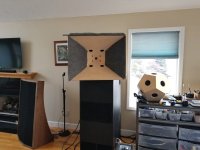Keele's classic paper still seems about as good as anything i've found for straight-sided conicals also using straight-sided secondary flares (synergy style)
https://www.xlrtechs.com/dbkeele.co...AES Preprint) - Whats So Sacred Exp Horns.pdf
https://www.xlrtechs.com/dbkeele.co...AES Preprint) - Whats So Sacred Exp Horns.pdf
And of course there is always the option of soft termination. AKA "Mad Dog" termination (foam at the mouth). Many ways to do that and the results are certainly audible.
Haha, yes indeed!
I'm always into Mad Dog mode
Currently trying some 1/2 thick felt pads on primary conical horn walls (synergy style).

I'm doing everything i can to keep from adding secondary flares in the usual manner. I can still carry the box without any disassembly, but wont be able to if secondary's are added. Trying to finalize the build for a stereo pair.
On a personal experience note...
So far, i must say every 'Mad Dog' type thing changes the sound a little.
HOM foam in the throat, mouth wrapped ala Charlie Hughes paper, acoutic foam strips placed in various places in the horn, felt on the walls, etc......all change the sound a little and polar measurements some.
The both good and bad news for me, has been once i retune/process whatever i've tried, there hasn't been enough audible difference to have bothered with it. Although the big felt panels may break that trend....??
By far the best solution is to make a proper termination to the horn itself. Everything else is just a band aid, if it works at all.
Absolutely! But so what?
If it sounds [or measures for some] 'right' then I don't really care how I got there and yes; I did some 'blind' testing using young women with proven really keen hearing to get a 'feel' for how much I could truncate and by then had plenty of experience WRT damping various size drivers, horn size/types from other by then, not so young females and since they were the folks I had to please, still wouldn't care how they measure if I should ever do any more DIY speakers using my much more 'real' testing 'equipment' than any electronic system's four decimal place accurate digital measurements.
In short, while we obviously have a need for technically correct solutions to a 'problem'/performance goal, in the real world it's more about making acceptable compromises.
On a personal experience note...
So far, i must say every 'Mad Dog' type thing changes the sound a little.
Although the big felt panels may break that trend....??
Should if at least 3/4", 1" carpet underlayment used for high end installs for a 'luxurious' and/or 'quiet' environment as folks don't realize how much damping in both density and surface area is required to audibly shape a [large] horn's and especially, a large woofer's response
Hi kipman, will do......
Pls do know i alot of what i try can be called "Hail Mary" DIY speaker building lol
Hi GM, wow...i've never even thought about using felt/absorption in a large horn to effect low freq response. Is that just to help reduce harmonic distortion, or are there some benefits that haven't yet crossed my mind.
So far, all my LF "clean up" efforts have been about having output that is super comfortable at the level driven (and more steeply low-passed than normal, since i can enjoy the benefits of being a FIR/ lin phase addict Lol)
Anyway, my biggest problem with mouth termination on my synergy builds (which are all roughly 4 ft wide and within 90x60) , has been in the 1-2 kHz range.
So I was thinking 1/2 felt is sufficient...
Can 1/2" cover that range in your experience?
But pls tell me more about LF horn dampening, all ears
Pls do know i alot of what i try can be called "Hail Mary" DIY speaker building lol
Hi GM, wow...i've never even thought about using felt/absorption in a large horn to effect low freq response. Is that just to help reduce harmonic distortion, or are there some benefits that haven't yet crossed my mind.
So far, all my LF "clean up" efforts have been about having output that is super comfortable at the level driven (and more steeply low-passed than normal, since i can enjoy the benefits of being a FIR/ lin phase addict Lol)
Anyway, my biggest problem with mouth termination on my synergy builds (which are all roughly 4 ft wide and within 90x60) , has been in the 1-2 kHz range.
So I was thinking 1/2 felt is sufficient...
Can 1/2" cover that range in your experience?
But pls tell me more about LF horn dampening, all ears
Absolutely! But so what?
In short, while we obviously have a need for technically correct solutions to a 'problem'/performance goal, in the real world it's more about making acceptable compromises.
So totally agree.
A speaker is a system...a full-range system.... with invariably differing goals and compromises.
Optimizing components of that system is wonderful, and perhaps the greatest beauty of DIY, the way we individually focus on optimizing particular aspects of the system, and learn from each others' specializations, and all collectively move forward.
But to make any one component, like an OS waveguide, or my linear phase processing, or any dang thing ....into a "most holy, must get absolutely correct component"...is completely nuts to me.
Not in, around, the edge and/or added baffle. You can use more dense in the horn if it has a rising response, but I've only had this issue with a few low compression horns.
That said, some folks have made a porous foam base to hold a dense material [crudely] shaped as a simple bullet or fully streamlined phase plug wedged in near the throat of point source horns, so plenty of tweaking options to turn a poorly designed horn up to something acceptable by typical DIY standards, i.e. they put 'x' driver in a horn designed for 'z' driver.
I mean look at how much damping can smooth out a crude TL, so same-same with horns, though of course we're always trading efficiency for BW, so really, that's our only fixed limiting factor.
That said, some folks have made a porous foam base to hold a dense material [crudely] shaped as a simple bullet or fully streamlined phase plug wedged in near the throat of point source horns, so plenty of tweaking options to turn a poorly designed horn up to something acceptable by typical DIY standards, i.e. they put 'x' driver in a horn designed for 'z' driver.
I mean look at how much damping can smooth out a crude TL, so same-same with horns, though of course we're always trading efficiency for BW, so really, that's our only fixed limiting factor.
Thx GM,
Yeah, i get there's a big diff in mouth termination issues, and internal horn reflection issues, aka HOMs, multiple sidewall reflections, etc ...at least in the paper world (eyes & brain).
I'm trying to sort out which matter in the audio world (ears & brain).
But specifically with regard to my conical synergy experiences,
i am currently convinced that 1/4 spacing of all contributing drivers
(and spot on mag resonse & phase/timing)...
ranks just below freq response (mag and phase), and definitely ahead of directivity curves (providing DI is half-way reasonable).
What is the lowest freq you think any kind of 'Mad Dog' felt/foam treatments make sense trying?
Yeah, i get there's a big diff in mouth termination issues, and internal horn reflection issues, aka HOMs, multiple sidewall reflections, etc ...at least in the paper world (eyes & brain).
I'm trying to sort out which matter in the audio world (ears & brain).
But specifically with regard to my conical synergy experiences,
i am currently convinced that 1/4 spacing of all contributing drivers
(and spot on mag resonse & phase/timing)...
ranks just below freq response (mag and phase), and definitely ahead of directivity curves (providing DI is half-way reasonable).
What is the lowest freq you think any kind of 'Mad Dog' felt/foam treatments make sense trying?
You're welcome!
Lowest I've done with horns is 300 Hz/2nd XO by the aforementioned ears only, so figure it was mostly to quell spurious HF and the horn/baffle was otherwise well damped via rigidity/mass loading.
That said, for below this frequency down to ~14 Hz tuning [lowest I've done], the pioneer's 'critically' damping a [horn] port with the click/impulse response test works a treat if not wanting a lot of HF out of it.
Lowest I've done with horns is 300 Hz/2nd XO by the aforementioned ears only, so figure it was mostly to quell spurious HF and the horn/baffle was otherwise well damped via rigidity/mass loading.
That said, for below this frequency down to ~14 Hz tuning [lowest I've done], the pioneer's 'critically' damping a [horn] port with the click/impulse response test works a treat if not wanting a lot of HF out of it.
- Home
- Loudspeakers
- Multi-Way
- Horn/waveguide flare termination
